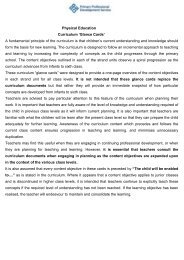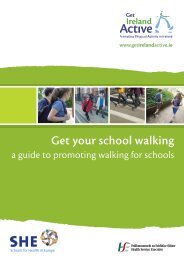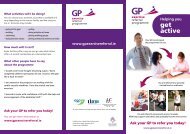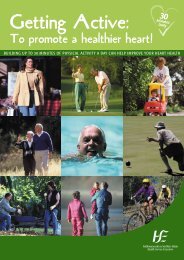Discover Cycling - Get Ireland Active
Discover Cycling - Get Ireland Active
Discover Cycling - Get Ireland Active
You also want an ePaper? Increase the reach of your titles
YUMPU automatically turns print PDFs into web optimized ePapers that Google loves.
Safety<br />
When cycling, it is important to think about your own safety and the safety of others.<br />
Whether cycling on the road or off-road always make sure your bike is in good working<br />
order before you set out.<br />
Always be courteous and cycle with respect for others, whether other cyclists,<br />
pedestrians, drivers or anyone else on your cycling route. This helps maintain your safety<br />
and the safety of others.<br />
Always wear a helmet while cycling. However, it is important to remember that a helmet<br />
will be of limited benefit in the event of a collision with a vehicle so don’t let yourself<br />
believe that you are protected from all eventualities just because you are wearing a<br />
helmet.<br />
<strong>Cycling</strong> on the road<br />
There is a big difference between cycling on<br />
a quiet country lane compared to the centre<br />
of a busy town or city, but wherever you<br />
cycle it is important to think about your<br />
safety at all times. Here are some tips:<br />
• Ensure you are familiar with the Rules of the<br />
Road – they apply to cyclists also. In particular<br />
refresh yourself with the specific rules for<br />
cyclists.<br />
• Maximise your visibility to other road users:<br />
- wear bright clothing.<br />
- if cycling at night fit lights to your bike and<br />
ensure they work properly.<br />
- at night wear clothing with reflective strips<br />
• Be alert to what’s happening around you. Don’t<br />
wear earphones while cycling.<br />
• Cycle decisively and make your intentions clear<br />
to other road users by using hand signals when<br />
planning to turn.<br />
• Think ahead, anticipate drivers’ actions and<br />
catch their eye.<br />
• Cycle well clear of the edge of the roadside or<br />
kerb – debris and drains at the road edge are a<br />
hazard.<br />
• Don’t cycle on footpaths intended for<br />
pedestrian use.<br />
• If cycling in a group, always warn any cyclists<br />
behind you of hazards ahead – such as<br />
potholes, parked cars, pedestrians, etc.<br />
<strong>Cycling</strong> Off-Road<br />
When cycling off-road there are usually<br />
no risks from motorised traffic but there<br />
are other potential risks and hazards<br />
which you need to be aware of.<br />
When cycling on paths which are used<br />
by pedestrians:<br />
• Give way to pedestrians, leaving them<br />
plenty of room and slow down or stop if<br />
necessary.<br />
• Be careful at junctions, bends and<br />
entrances.<br />
• Don’t assume that other users can see or<br />
hear you – use a bell – don’t surprise<br />
people.<br />
When cycling on mountain bike trails:<br />
• <strong>Get</strong> an understanding of how your bike<br />
reacts to different surfaces .e.g. can slide<br />
on wet rocks.<br />
• Match your speed to the surface and your<br />
bike handling skills.<br />
• On purpose-built trails, check the difficulty<br />
rating and cycle trails that match your skill<br />
and fitness.<br />
• Don’t be over confident about your<br />
abilities on your first time out on a trail.<br />
• Always expect the unexpected – e.g. a<br />
sudden drop or rock on the trail.<br />
22









